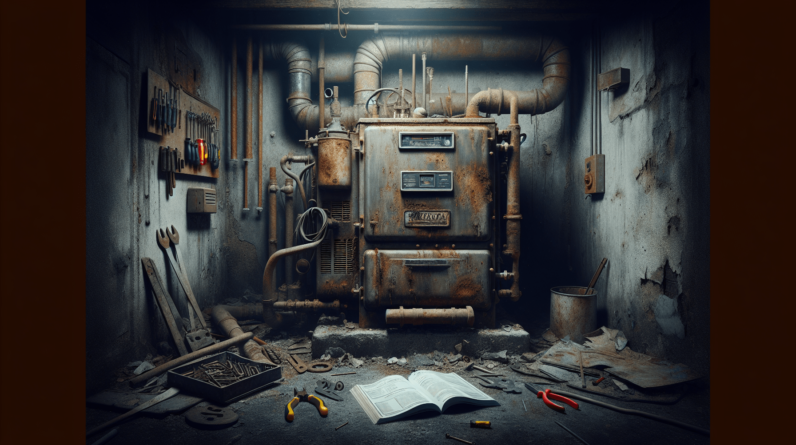
Imagine this scenario: you enter your home after a long day at work, only to discover a mysterious puddle of water on the floor. As panic sets in, you start to wonder: could there be a leak in your water pipe? Don’t worry, dear reader, for this article is here to guide you through the signs that might indicate a leaking water pipe. From unusual sounds to sudden spikes in your water bill, we will unravel the mysteries of water pipe leaks and empower you with knowledge to take control of the situation.
Signs of a Leaking Water Pipe
When it comes to detecting a leaking water pipe, there are several signs you should be aware of. By recognizing these signs early on, you can take the necessary steps to address the issue promptly and prevent further damage. Let’s take a closer look at some of the most common signs of a leaking water pipe:
Water Stains
One of the first signs you may notice if you have a leaking water pipe is the presence of water stains. These stains can appear on ceilings, walls, or floors, and are often brownish or yellowish in color. They occur when water seeps through the walls or ceiling due to a hidden pipe leak. If you notice any discoloration or staining, it’s important to investigate further to determine the source of the leak.
Dampness or Moisture
Another sign of a leaking water pipe is the presence of dampness or moisture in certain areas of your home. This can manifest as wet spots on the floor, carpet, or walls. If you come across any areas that feel consistently damp or moist, it’s a clear indication that there may be a water leak nearby. It’s crucial to address this issue promptly to prevent mold growth and structural damage.
Low Water Pressure
If you suddenly experience a significant drop in water pressure, it could be a sign of a leaking water pipe. A leak in the plumbing system can disrupt the flow of water, resulting in reduced pressure at your faucets and showerheads. If you notice a decrease in water pressure, it’s important to investigate the cause to rule out a potential leak.
Unusually High Water Bills
One of the clearest indicators of a water pipe leak is an unexpected increase in your water bills. If your water usage has not changed significantly but you notice a sudden spike in your bills, it’s a strong indication that there may be a hidden leak in your plumbing system. Monitoring your water bills closely and comparing them to previous usage patterns can help you identify abnormal consumption and take action if needed.
Mold or Mildew
The growth of mold or mildew in your home can also be a sign of a leaking water pipe. These fungi thrive in damp environments, making them a common occurrence in areas affected by water leaks. If you notice any mold or mildew on walls, ceilings, or around plumbing fixtures, it’s essential to address the underlying water issue and perform remediation to prevent further damage to your property and potential health risks.
Musty Odor
A musty odor lingering in your home can be a telltale sign of a water pipe leak. When water seeps into hidden spaces or accumulates in walls, it creates a perfect breeding ground for mold and mildew. The resulting musty smell can permeate the air and indicate the presence of a hidden leak. If you notice a persistent musty odor, it’s crucial to investigate further and address the issue promptly to prevent further damage and maintain a healthy living environment.
Pooling Water
If you come across pooling water in your home, it’s an obvious indication of a water leak. This can manifest as puddles on the floor, water seeping through cracks, or water accumulating in certain areas. Pooling water can cause significant damage to your property, so it’s essential to take immediate action to identify and resolve the source of the leak.
Sounds of Running Water
Sometimes, you can detect a leaking water pipe by simply listening for the sound of running water. Even if you can’t visually see any signs of leakage, the sound of water continuously flowing or dripping can indicate a hidden pipe leak. If you hear any unusual sounds of running water in your home, it’s advisable to investigate further to prevent any potential damage.
Drop in Water Temperature
A sudden drop in water temperature can also indicate a leaking water pipe. When water leaks from the pipes, it can mix with cold water, resulting in a noticeable decrease in water temperature at your faucets and showers. If you experience a significant change in water temperature, it’s worth investigating the possibility of a leaking pipe to prevent further damage and maintain comfortable water temperatures.
Visible Physical Damage
In some cases, a leaking water pipe may cause visible physical damage to your property. This can include warped or sagging walls, peeling paint or wallpaper, or even a bulging ceiling. If you notice any of these physical changes, it’s essential to investigate the cause promptly to prevent further damage and potential safety hazards.
Methods to Detect Water Pipe Leaks
Now that you’re familiar with the signs of a leaking water pipe, let’s explore the various methods you can use to detect these leaks. By employing these detection techniques, you can quickly identify the source of the leak and take appropriate action. Here are some common methods used for detecting water pipe leaks:
Check Water Meter
One of the simplest ways to detect a water pipe leak is by checking your water meter. Start by turning off all the water sources in your home and ensure that no appliances, like dishwashers or washing machines, are in use. Take note of the meter reading and wait for a few hours without using any water. If the meter reading changes during this period, it indicates the presence of a leak.
Listen for Hissing or Dripping Sounds
Another effective method is to listen for hissing or dripping sounds in your home. Turn off any appliances or devices that may create background noise and listen carefully near your pipes, fixtures, and walls. If you hear any unusual sounds of hissing or dripping, it’s a strong indication of a potential water pipe leak that requires further investigation.
Visual Inspection
Performing a visual inspection of your plumbing system is another valuable method for detecting water pipe leaks. Check for any visible signs of leakage, such as water stains, dampness, or physical damage to the pipes. It’s crucial to inspect all accessible areas, including basements, crawl spaces, and attics, to ensure you don’t miss any potential leaks.
Use of Water Leak Detection Tools
Water leak detection tools are specifically designed to help pinpoint the source of a water pipe leak. These tools include electronic leak detectors, which use sound waves to amplify the sound of a leak and locate its exact location. There are also moisture meters that can detect the presence of dampness or excessive moisture in walls, ceilings, and floors. Using these tools can provide accurate results and help you detect hidden leaks that may not be visible to the naked eye.
Pressure Testing
Pressure testing is a method commonly used by professionals to detect water pipe leaks. It involves temporarily increasing the pressure in the plumbing system to identify any drops in pressure that may indicate a leak. This method requires specialized equipment and expertise, so it’s best to consult a professional plumber if you suspect a leak and want to conduct a pressure test.
Dye Testing
Dye testing is a technique used to detect leaks in toilets and drains. It involves adding a colored dye, such as food coloring, to the water in the tank or drain. If there is a leak, the colored water will seep into the bowl or surrounding area, indicating the presence of a leak. Dye testing is a simple and cost-effective way to detect leaks in specific fixtures.

Thermal Imaging
Thermal imaging cameras are advanced tools that can detect changes in temperature and identify areas of moisture or water leakage. By capturing infrared images of your home, these cameras can detect temperature variations that may indicate the presence of a hidden water pipe leak. Thermal imaging is particularly useful for identifying leaks behind walls, under floors, or in other concealed areas.
Acoustic Monitoring
Acoustic monitoring is a method that uses specialized equipment to listen for the sound of water escaping from pipes. It involves placing sensors in key areas and using microphones to capture sounds at various frequencies. By analyzing the captured audio, professionals can identify potential leaks and determine their exact location. Acoustic monitoring is a highly accurate and non-invasive method for detecting water pipe leaks.
Pipe Inspection Cameras
Pipe inspection cameras, also known as borescopes or plumbing cameras, are small cameras attached to a flexible cable. These cameras allow professionals to visually inspect the inside of pipes and identify any cracks, corrosion, or other signs of damage that may be causing a leak. Pipe inspection cameras are particularly useful for assessing the condition of hidden pipes and determining the extent of the damage.
Professional Assistance
In many cases, the most reliable method for detecting and addressing water pipe leaks is to seek professional assistance. Licensed plumbers have the expertise, experience, and specialized equipment needed to accurately detect and repair leaks in your plumbing system. They can perform comprehensive inspections and provide prompt solutions, ensuring that the leak is thoroughly addressed to prevent further damage.
Actions to Take If Water Pipe Leaks
If you’ve identified a water pipe leak in your home, it’s important to take immediate action to prevent further damage and address the issue properly. Here are some key actions to take if you discover a water pipe leak:
Turn Off the Water Supply
The first step is to turn off the water supply to the affected area or the entire house. This will help minimize the amount of water leaking and prevent further damage. Locate the main shut-off valve and turn it clockwise until it is fully closed. If you’re unsure of the location of the shut-off valve, consult a professional plumber or refer to your home’s plumbing system documentation.
Identify the Source of the Leak
Next, you’ll need to identify the source of the leak. Thoroughly inspect the area, checking for visible signs of leakage, dampness, or pooling water. Follow any visible water trails to trace the origin of the leak. If the source is not immediately apparent or the leak is hidden, it’s advisable to seek professional help to accurately locate and assess the extent of the leak.
Try Temporary Fixes
If the leak is minor and you are unable to get immediate professional assistance, you may consider trying temporary fixes to contain the leak temporarily. This can include using plumbing tape or epoxy putty to seal small leaks or using buckets or towels to catch dripping water. However, temporary fixes should only be used as a temporary measure until a permanent solution can be implemented.
Contact a Professional Plumber
For more severe or hidden leaks, it’s advisable to contact a professional plumber as soon as possible. Licensed plumbers have the expertise and knowledge to accurately diagnose and repair water pipe leaks. They can recommend the most appropriate repair method based on the type and location of the leak, ensuring a long-lasting solution.
Repair or Replace the Pipe
Depending on the severity and location of the leak, the plumber may suggest repairing or replacing the damaged pipe. In some cases, a simple repair, such as patching a small hole or replacing a faulty joint, may be sufficient. However, if the pipe is severely corroded or damaged, it may be necessary to replace the entire section or even the entire plumbing system.
Inspect for Water Damage
Once the leak has been repaired, it’s important to thoroughly inspect your home for any water damage. This includes checking for water stains, mold growth, or structural damage. Address any water damage promptly to prevent further issues, such as mold infestation or weakened structural integrity.
Check Insurance Coverage
If the water pipe leak has resulted in significant damage to your property, it’s essential to check your insurance coverage. Homeowners’ insurance policies may provide coverage for water damage caused by certain types of pipe leaks. Contact your insurance provider to understand your coverage and file a claim if necessary.
Prevent Future Leaks
To minimize the risk of future water pipe leaks, it’s crucial to implement preventive measures. This can include regularly inspecting your plumbing system for any signs of wear or damage, maintaining proper insulation to prevent freezing pipes, and taking precautions when landscaping near your water lines. Additionally, consider installing water leak detectors or automatic shut-off valves to provide early detection and mitigation in case of future leaks.
Water Stains
Definition and Appearance
Water stains are discolorations or marks on surfaces caused by water seeping through. They can appear as yellowish or brownish patches on ceilings, walls, or floors. Water stains are a common sign of a leaking water pipe and indicate that water has infiltrated the surface in some way.
Causes of Water Stains
Water stains can occur due to various reasons, including leaking pipes, roof leaks, plumbing issues, or condensation. When a water pipe leak occurs, water can seep through walls, ceilings, or floors, resulting in visible stains. Roof leaks or plumbing issues can also lead to water infiltration and staining. Additionally, condensation can cause moisture to accumulate, resulting in water stains on surfaces.
Inspection and Remediation
When you notice water stains in your home, it’s important to inspect the area carefully to determine the source of the leak. Thoroughly check nearby plumbing fixtures, pipes, and walls for any visible signs of leaks or dampness. If the source of the leak is visible and accessible, you can attempt to repair it yourself if you have the necessary skills and tools. However, for hidden or complex leaks, it’s advisable to seek professional assistance to accurately identify and remediate the issue.
Dampness or Moisture
Definition and Causes
Dampness or moisture refers to the presence of excessive moisture in certain areas of your home. This can manifest as wet spots on the floor, carpets, or walls, indicating the presence of a water leak. Dampness can occur due to various reasons, such as leaking water pipes, faulty plumbing fixtures, or high humidity levels.
Areas Prone to Dampness
Certain areas of your home are more prone to dampness than others. Basements, bathrooms, kitchens, and laundry rooms are common areas where water leaks or high humidity levels can lead to dampness. Additionally, areas near plumbing fixtures and pipes are susceptible to dampness if there are any leaks or condensation issues.
Steps to Deal with Dampness
When dealing with dampness in your home, it’s crucial to take immediate action to prevent further damage and mold growth. Start by identifying the source of the dampness, which can be a leaking water pipe or a plumbing fixture. Address the underlying issue by repairing or replacing the damaged pipe or fixture. Additionally, ensure proper ventilation in the affected area to reduce humidity levels. Use dehumidifiers or fans to dry out damp surfaces and prevent the growth of mold or mildew.






